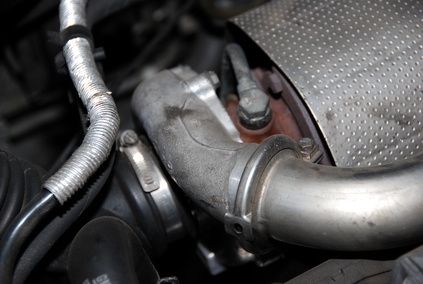
If the idea of making horsepower with water seems strange, then that's because you can't. Like all other turbocharged engines, diesels make power by using an exhaust-driven compressor to shove air into the engine. Compressing air makes it hotter, which increases the likelihood of detonation in the cylinders. In a diesel, this equates to higher exhaust gas temperatures and loss of power. Installing a water-injection system is only the first step in tuning it and and using it to safely increase turbo boost and horsepower output.
Set your desired exhaust gas temperature goals. Exhaust gas temperatures (EGT) should typically fall within about 50 degrees of the stock specification, since this represents the engine's ideal operating range from an efficiency, safety and emissions standpoint. A very low EGT means that you're losing horsepower, and very high EGTs increase the odds of damage to the engine.
Run your truck either on a dragstrip or wheel dynamometer, and have an assistant carefully record the EGTs at every given rpm and boost level. A data-logging engine tuner will come in very handy here, since it will record every variable in a single run.
Increase injector orifice size if the EGT levels shoot up to the desired level and then slowly climb to higher temperatures as the boost increases. For most boost kits, changing orifice size will involve unscrewing the injector from the boost tube, then unscrewing the old orifice from the tip of the injector and replacing it with an orifice with a larger hole. For some other kits, the orifice (jet) is located in the water solenoid output. Unscrew the line from the solenoid, remove the old jet and slide the new one into place in the solenoid output.
Lower the water-injection engagement boost level and reduce the injector orifice size if the EGTs remain stable at lower boost levels, suddenly spike at middle boost levels and quickly drop when the water injection system kicks in. Your power tuner should have provisions to lower the boost level electronically; access the control menu and follow the tuner manufacturer's recommendations to reduce the boost. The procedure for reducing orifice size is the same as increasing it; you need only install a jet with a smaller hole instead of a larger one.
Add a second stage with a slightly smaller orifice size if, after Step 4, your EGTs rise past the desired level as described in Step 3. Set the second stage to engage just below the boost pressure level where the engine reaches its ideal EGT. The second stage installs just like the first one; the only difference between the first and second-stage installation is that they both draw from the same reservoir tank.
Add methanol to the water injection tank so achieve a 25/75 mixture of methanol and water. The EGT readings will rise slightly but linearly across the board, but -- because the methanol is a fuel -- power will increase along with it. If the EGTs remain within an acceptable range, increase the mixture to 50/50 water methanol. The exhaust gas temperatures will rise noticeably, as will the horsepower and torque. Setting the injection-engagement point for the second stage is just like changing the first stage. If you're using an electronic control box, follow the manufacturer recommendations to change the engagement point. If you're using a manual control valve, turn the adjuster screw clockwise to raise the boost-engagement point and counterclockwise to lower it.
Increase orifice size until the EGTs drop back to the ideal range. Follow the above-described procedures for changing orifice size. At this point, your water/methanol injection system should be optimized for the engine and turbo combination.